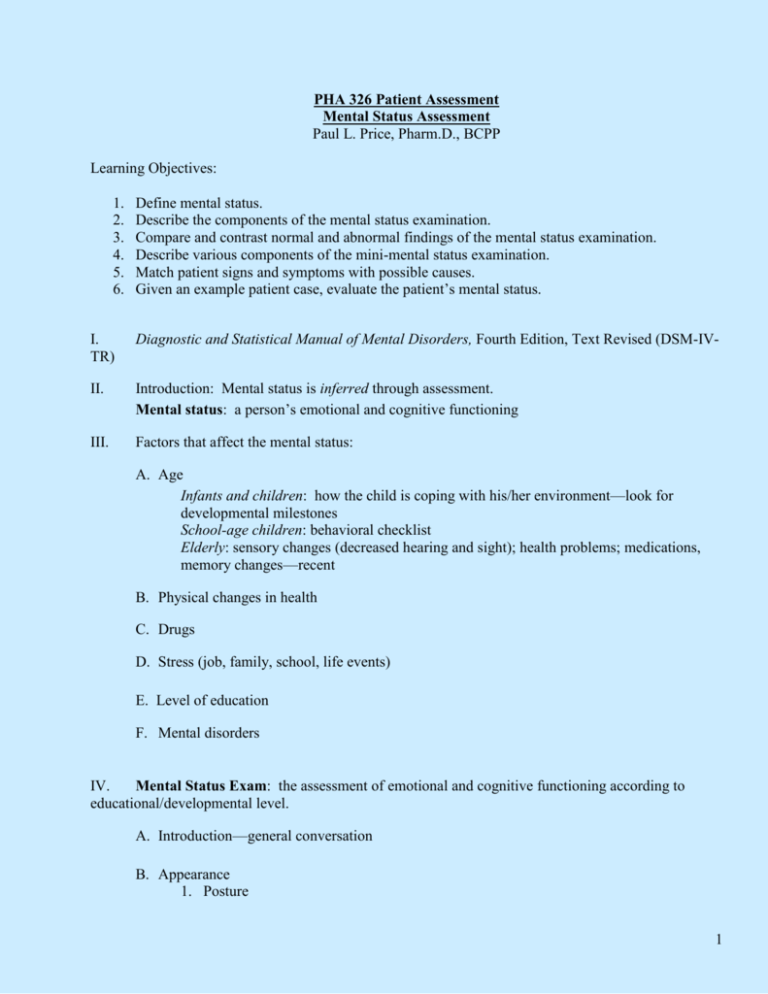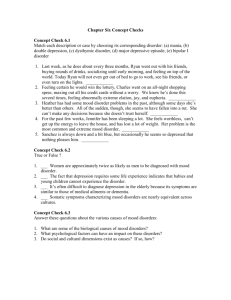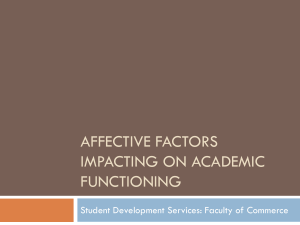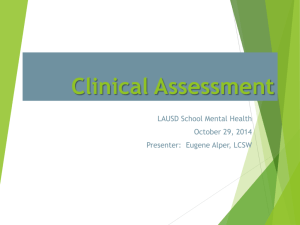Mental Status Assessment
advertisement

PHA 326 Patient Assessment Mental Status Assessment Paul L. Price, Pharm.D., BCPP Learning Objectives: 1. 2. 3. 4. 5. 6. Define mental status. Describe the components of the mental status examination. Compare and contrast normal and abnormal findings of the mental status examination. Describe various components of the mini-mental status examination. Match patient signs and symptoms with possible causes. Given an example patient case, evaluate the patient’s mental status. I. TR) Diagnostic and Statistical Manual of Mental Disorders, Fourth Edition, Text Revised (DSM-IV- II. Introduction: Mental status is inferred through assessment. Mental status: a person’s emotional and cognitive functioning III. Factors that affect the mental status: A. Age Infants and children: how the child is coping with his/her environment—look for developmental milestones School-age children: behavioral checklist Elderly: sensory changes (decreased hearing and sight); health problems; medications, memory changes—recent B. Physical changes in health C. Drugs D. Stress (job, family, school, life events) E. Level of education F. Mental disorders IV. Mental Status Exam: the assessment of emotional and cognitive functioning according to educational/developmental level. A. Introduction—general conversation B. Appearance 1. Posture 1 2. Body movements 3. Dress (appropriate for setting, season, age, gender, and social group) 4. Grooming and hygiene C. Behavior 1. Level of Consciousness a) Alert: awake and fully aware of external and internal stimuli b) Lethargic: not fully alert, drifts off to sleep when not stimulated c) Obtunded: sleeps most of the time, difficult to arouse d) Stupor: spontaneously unconscious, responds only to persistent and vigorous shakes e) Coma: completely unconscious, no response to pain or stimuli 2. Facial Expression – eye contact 3. Speech a) Pace of the conversation b) Articulation (1) Dysarthria: distorted speech sounds, language intact, disorder of articulation (2) Aphasia: language comprehension and production disturbance due to brain damage (e.g., CVA/stroke) c) Mood and Affect (1) Affect: short-term emotional status—a temporary expression of feelings or state of mind (2) Affect descriptors: flat, inappropriate, labile, sad, gloomy, joyful (3) Mood: long-term emotional status—a prolonged display of feelings that reflect the whole emotional state of the person (4) Mood descriptors: (see Box 19-2 for Major Depression) depression, euphoria, dysthymia, euthymia D. Cognitive Functions 1. Orientation: Time, Place, Person (Ox3) a) Disorientation—drugs, delirium, dementia 2. Attention Span: ability to concentrate and focus on one specific activity without being distracted by environmental stimuli. a) Assess with a variety of tests (e.g., spell a word backwards, digit sequence recall) b) Affected by: anxiety, fatigue, drugs/alcohol 3. Recent Memory: last few days, 24-hour diet recall, confabulation? a) Affected by: delirium, dementia, amnesia, Korsakoff’s syndrome in chronic alcoholism, Alzheimer’s dementia, depression, anxiety 4. Remote/Long-Term Memory: past events from years ago a) Affected by: advanced Alzheimer’s dementia, damage to the cerebral cortex 5. New Learning: ability to create new memories a) Three or four words – ask to repeat in five minutes b) Affected by: dementia, anxiety, depression 2 6. Abstract Reasoning 7. Insight and Judgment 8. Ability to Perform Complex Acts 9. Level of Ambivalence E. Thought Processes and Perceptions 1. Thought processes: “Does this person make sense?” “Can I follow what the person is saying?” a) Blocking: stops in the middle of a thought (schizophrenia, drug side effects) b) Confabulation: fabricates info. to fill in memory gaps c) Loosening of associations: combines unrelated topics or words (schizophrenia, severe stages of mania) d) Flight of ideas: change from topic to topic with an apparent connection between the topics. (acute phases of mania 2. Thought Content: What the person says. a) Delusion: fixed, false belief (1) Subtypes: Grandiose—believes he or she is God/famous person; Persecution (paranoid)—“they are out to get me” b) Phobia: fear of an object, situation c) Hypochondriasis: worries about own health, sick with no actual basis for that assumption d) Obsession: repetitive thought e) Compulsion: repetitive action, behavior 3. Perceptions: should be aware of reality. a) Hallucinations: sensory perception with no external stimuli (1) 5 senses—auditory, visual, tactile, olfactory, gustatory (2) psychiatric, organic brain disease: auditory and visual hallucinations (3) alcohol withdrawal: tactile hallucinations b) Illusion: misperception of an actual existing stimulus 4. Screen for suicidal thoughts a) When a person expresses feelings of sadness, hopelessness, despair of grief. b) Self-harm, suicidal ideation or plans c) Warning signs of suicide: (1) Prior suicide attempts (2) Depression, hopelessness (3) Social withdrawal, running away (4) Self-mutilation (5) Insomnia (6) Slowed psychomotor activity (7) Anorexia (8) Verbal suicide messages (9) Death themes in art, jokes, writings 3 (10) V. Saying goodbye, giving away personal belongings Abnormal Findings A. Delirium: disturbance of consciousness with a reduced ability to focus, sustain attention 1. Change in cognition 2. Develops over a short period of time (hours to days) 3. Identifiable cause—usually reversible (infections, metabolic disorders, liver or kidney disease, head trauma, medications) B. Dementia: development of multiple cognitive deficits 1. Memory impairment 2. Cognitive disturbances a) Aphasia (language) b) Apraxia (motor) c) Agnosia (identifying objects) 3. Loss of functioning 4. May have an identifiable cause—usually irreversible (dementia of Alzheimer’s type (DAT), cerebrovascular disease) C. Amnestic Disorder 1. Memory impairment 2. Loss of functioning 3. Identifiable cause—accident, drug-induced D. Substance Use Disorders (taken nonmedically to alter mood or behavior) 1. Intoxication—disinhibition 2. Abuse—daily use to function, inability to stop, impaired functioning 3. Dependence—physiologic or psychological dependence on substance 4. Tolerance—requires increased amount of substance to produce same effect 5. Withdrawal—cessation of substance produces physiological symptoms E. Schizophrenia (two or more of the following) 1. Delusions 2. Hallucinations 3. Loosening of associations 4. Ambivalence 5. Flat or inappropriate affect 6. Loss of functioning 7. Duration of at least 6 months F. Mood Disorders 1. Major Depression (vs. grief reaction) a) Depressed mood—most of the day, nearly everyday b) Anhedonia—diminished interest or pleasure in most or all activities c) Weight loss or gain d) Insomnia or hypersomnia e) Psychomotor agitation or retardation f) Fatigue or loss of energy g) Feelings of worthlessness, excessive or inappropriate guilt h) Diminished ability to think or concentrate 4 2. 3. 4. 5. VI. i) Recurrent thought of death, plans for suicide Manic Episode a) A distinct period of abnormally and persistently elevated, expansive, or irritable mood lasting at least 1 week b) Inflated self-esteem or grandiosity c) Decreased need for sleep (feels rested after only 3 hours of sleep) d) More talkative than usual e) Flight of ideas (thoughts are racing) f) Distractibility g) Increase in activity (work, school, etc.) (person does not finish it) h) Increase in pleasurable activities that have a high potential for painful consequences (e.g., buying sprees, food binges, etc.) Dysthymic Disorder a) At least 2 years of depressed mood, along with other depressive symptoms Bipolar Disorder a) Swings/cycles between major depressive episodes and manic episodes Anxiety Disorders a) Generalized Anxiety Disorder (1) Excessive anxiety and worry (2) Restlessness/on edge (3) Easily fatigued (4) Difficulty concentrating (5) Irritability (6) Muscle tension (7) Sleep disturbance b) Obsessive-Compulsive Disorder c) Posttraumatic Stress Disorder d) Specific Phobias e) Social Phobias Mini-Mental State Exam A. A simplified form of the cognitive functions of the mental status examination. (only cognitive functioning—not on mood or thought processes) B. Quick and easy (5-10 minutes to administer) C. Standard set of 11 questions (see example form http://classes.kumc.edu/som/amed900/assessment/AgingGame/MMSE.htm) (Also see a video of a health care provider administering the mini-mental state exam to a patient http://classes.kumc.edu/som/amed900/assessment/AgingGame/Aging_games_moodmemory.htm – you will need to scroll to the bottom of the web page to click on links) 5








